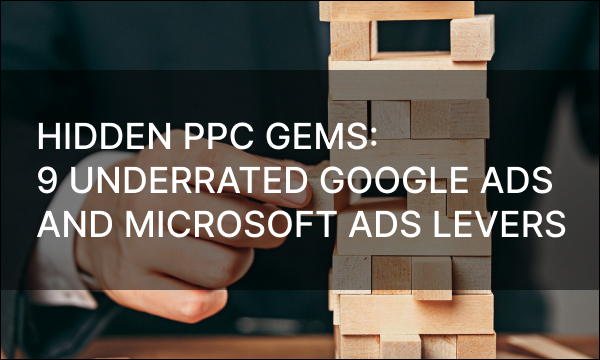A brief look at the power of Bing advertising and the importance of optimizing it to improve your visitor experience.
Even though Google leads the search at the moment, grabbing the lion’s share of the market, Bing Ads shouldn’t be an afterthought. Marketers should learn how to leverage the power of Bing Ads to reach a new audience and boost sales. Bing has recently returned with a powerful support from ChatGBT, and a powerful language model developed by OpenAI. Bing now delivers more accurate search results and better ad targeting through understanding natural language and delivering relevant answers to the most complex queries.
Bing Ads allows businesses to expand their online presence and reach new customers. The competitive advantage over Google lies in offering more complex and advanced search. We’ll explore the benefits of Bing Ads and explain why your business should use them. We’ll look at what makes Bing Ads great, and show you how to optimize your ad campaigns.
What are Bing Ads and Why Use Them
As a powerful advertising platform, Bing Ads allows businesses to create and advertise on the Microsoft search network, which includes Bing, Yahoo and AOL. In total, it reaches 7.3 billion searches per month and holds a combined 33% share of the US search market. The broad reach of the Microsoft search network allows companies to target audiences that are different from Google Ads and expand the impact of their advertising campaigns.
Bing Ads are similar to Google Ads in that they are based on an auction system that allows advertisers to bid on specific keywords. The difference is that they can be placed anywhere in Microsoft’s network of websites and applications. This ensures your ads receive maximum visibility across the Microsoft ad network, including sites and partner placements.
Bing Ads are placed above organic search results. They are displayed on every page of your website, even if there are no ads from Bing. Bing can also show ads on the right side of your website’s pages helping create an effective call to action for visitors. The prospects see engaging video content or product pages before moving on to a competitor’s site.
Why Use Bing Ads
Although Google owns the overwhelming majority of the global search market, Microsoft’s search engine ranks second. This gap may indeed seem significant, but with over 1 billion unique visitors to Bing every month, plenty of people use it. If you’re targeting PC users specifically, Bing is ideal. According to the Microsoft Search Network, the platforms handle 14.7 billion desktop searches per month, which is equivalent to 653 million unique PC users.
However, there are many factors to consider beyond the audience size, particularly the difference between cost per click (CPC) and click-through rate (CTR) on each platform. You may wonder what it is Bing Ads can do that Google Ads can’t, as well as what benefits Microsoft Advertising can offer. We’ll give you the answers below.
Most small and medium businesses know the importance of advertising on Google Ads, but somehow ignore Bing Ads. Meanwhile, setting up a marketing campaign in Bing Ads is no more difficult than setting up a marketing campaign in Google Ads. There are many attractive benefits to using Bing Ads for business.
1. More places for advertising
When you use Bing Ads, your ads will actually be displayed across multiple sites, as they own Bing, MSN, Yahoo, and AOL. Microsoft and Yahoo may also be featured on several smaller affiliate sites that are owned and operated by syndicated search partners. If your customers use Outlook more often than Gmail, Bing Ads is right for you. You can narrow your ad distribution based on where you want your ads to appear. You can also decide where you want your ads to appear.
2. Less competition
Search engines associated with Microsoft Advertising have a smaller audience segment, which means less competition for top placement. This also means that fewer other advertisers affect the cost of your advertising. Clicks become cheaper, prime spots are easier to take, and advertisers get more profit for their dollars.
3. Detailed targeting
Bing allows you to get specific ad targeting information at the campaign level. These tools also help you make targeting changes at the ad group level to make your ad campaigns more flexible. Bing Ads let you schedule your ads to run at a specific time in your users’ time zone, regardless of their location. Besides, you can target audiences based specifically on their devices or operating systems.
4. LinkedIn profile targeting capabilities
Bing Ads allows you to target the most relevant audiences using profile information from LinkedIn. Therefore, you can apply bid modifiers based on the information you get from LinkedIn. You can target Bing ad campaigns based on data such as companies, industries, and job titles. This feature is a game changer for B2B services. If you want to attract people to your company or goods, start by identifying the top ten clients on your wish list, find their company, specify the industry, and target the highly relevant audiences.
Types of Bing Ads
 Photo by Julian Hochgesang on Unsplash
Photo by Julian Hochgesang on Unsplash
Here are the most popular and effective types of Bing Ads:
App Install Ads
A powerful advertising tool for online retailers increases mobile app downloads. It helps you effectively reach relevant audiences across the Microsoft ad network and motivate installations of your mobile app. In other words, the focus is on app downloads rather than website traffic. App install ads contain direct links to your apps, as well as a convenient button that immediately sends customers to the appropriate app store for a quick download.
Expanded Text Ads
Additional titles and descriptions improve user engagement and conversions. This advertising type consists of ad titles with support for three headlines, ad text allowing for two descriptions, an automatically generated display URL with domain and subdomain, along with two customizable URL paths, and the final URL.
Responsive Search Ads
Multiple titles and descriptions help Bing dynamically generate the most relevant and compelling ad copy for each search query. The process of creating and testing ads is easier and more efficient. You can provide up to 15 titles and 4 descriptions, and Bing Ads automatically create and serve the best combinations based on the user’s query. This automation saves time and increases ad engagement by delivering highly relevant and personalized ads to prospects.
Dynamic Search Ads
A simple and powerful advertising solution for online retailers that targets relevant search queries. Automatically generated personalized ads based on your website ensure they match specific queries. Whether it’s an entire website or specific pages and categories, these ads intelligently adapt to match the query and deliver highly targeted messages to prospects. They save time because there is no need for keyword lists, bid management, or customizing ad titles.
Audience Ads
A great opportunity for the advertisers to get more high-quality traffic from sources other than search placements. These ads are intuitively integrated into articles and blend seamlessly with surrounding page content while remaining visually engaging. Advertisers can target customer categories based on demographics, interests and behavior and deliver relevant ads to the audiences that are ready to convert, driving the performance of their ad campaigns.
Multimedia Ads
Visually appealing creatives capture prospects’ attention and showcase a brand and its products. Large visual elements used in these ads increase website traffic and sales. Multimedia ads include the optimal combination of titles, descriptions, images and logos to match users’ search queries. They appear in prominent positions in the main and sidebars, without replacing existing text ad placements.
Product Ads
A useful tool for the advertisers to showcase their products via custom images from their own product catalogs within the Microsoft Merchant Center. These ads include promotional text, pricing, ratings and seller details, as well as other relevant information. Specific product information provides insight into when and where advertisements will appear.
Vertical Ads
Dynamic data feeds generate personalized ads that are clearly targeted to the specific industry verticals, such as automotive, credit card, cruises, health insurance, professional services, real estate, tax, and tours and activities categories. Instead of keywords, Microsoft AI dynamically generates personalized ads to improve CTR and lower CPC rates based on historical performance data. This ad format helps advertisers improve ad performance with high-quality placements and achieve better results for their business.
Display Ads
Advertising appears on websites, apps, and social media platforms in the form of static images, interactive banners, or even video content. This ad format comes in various sizes and formats to capture user’s attention and drive traffic to a specific landing page or website.
Native Ads
Advertising blends seamlessly with the content on a website or platform. It matches the appearance of surrounding content, offering non-disruptive and engaging user experience. This ad format is often presented as sponsored articles, recommended content, or in-stream ads on social media platforms.
Video Ads
Video content effectively delivers a short message or showcases products and services appearing on various websites, social media and video-sharing platforms. Video ads can be in pre-roll, mid-roll, or post-roll ads depending on their placement within a video player.
How to Optimize Bing Ads
Get ready to create your own effective Bing Ads strategy to boost your sales, drive conversions, and maximize your ROI. Here are some pro tips from keyword optimization to audience targeting.
1. Keyword Research
First of all, you should find out what people are searching for. The most popular is Keyword Research Tool provided by Microsoft for free. It allows you to access search volume data for different keywords.
2. Audience Reach
To ensure your Bing Ads are effective, it’s important to know your audience and match your advertising strategy accordingly. To maximize your ROI, you need to focus on optimizing your advertising approach and reaching the right audience. Creating a detailed customer profile and identifying their preferences will help you determine whether Bing is right for your advertising goals.
3. Import Google Ads Campaigns into Bing Ads
Microsoft allows you to import your Google Ads campaigns into Bing Ads and thus saves you time. Instead of starting from the very beginning, importing your successful campaigns will save you time and effort of running ads on this platform. If your Google Ads campaigns are already performing well, it’s a smart way to import them into Bing Ads.
4. Targeting Optimization
Most people prefer personalized advertising based on their interests. To maximize your Bing Ads performance, you need to ensure they reach the right audience. You can maximize conversions and make the most of your budget by strategically timing your ads.
5. Advantage of the UET Tag
To ensure accurate tracking of your conversions, you should set up the Universal Event Tracking (UET) tag. It provides detailed information about user behavior after they click your ad and visit your site. This tag determines whether a user quickly leaves your landing page or makes a purchase.
6. Quality Score
When it comes to Bing Ads, understanding your Quality Score is key to staying competitive. A low quality score indicates that your ads are not showing up as often as you’d like, while a high quality score indicates that your ad has competitive keywords and CTR, so it’s likely to show up more often.
Conclusion
In the age of online marketing, it is necessary to develop a well-planned marketing strategy including PPC trends and SEO trends to achieve your target goals. Bing Ads opens up virtually limitless opportunities to advertise your business and increase sales. Bing Ads are easy to set up, offer plenty of features and provide more flexibility than Google Ads.
While Google leads the way in search engines, Microsoft Bing is not far behind. Bing ad optimization strategy helps the target audience reach your landing page, generates leads, and improves PPC campaign conversion rate. All you have to do is work on ad scheduling, geotargeting, and other features to get more clicks on your Bing ads.


